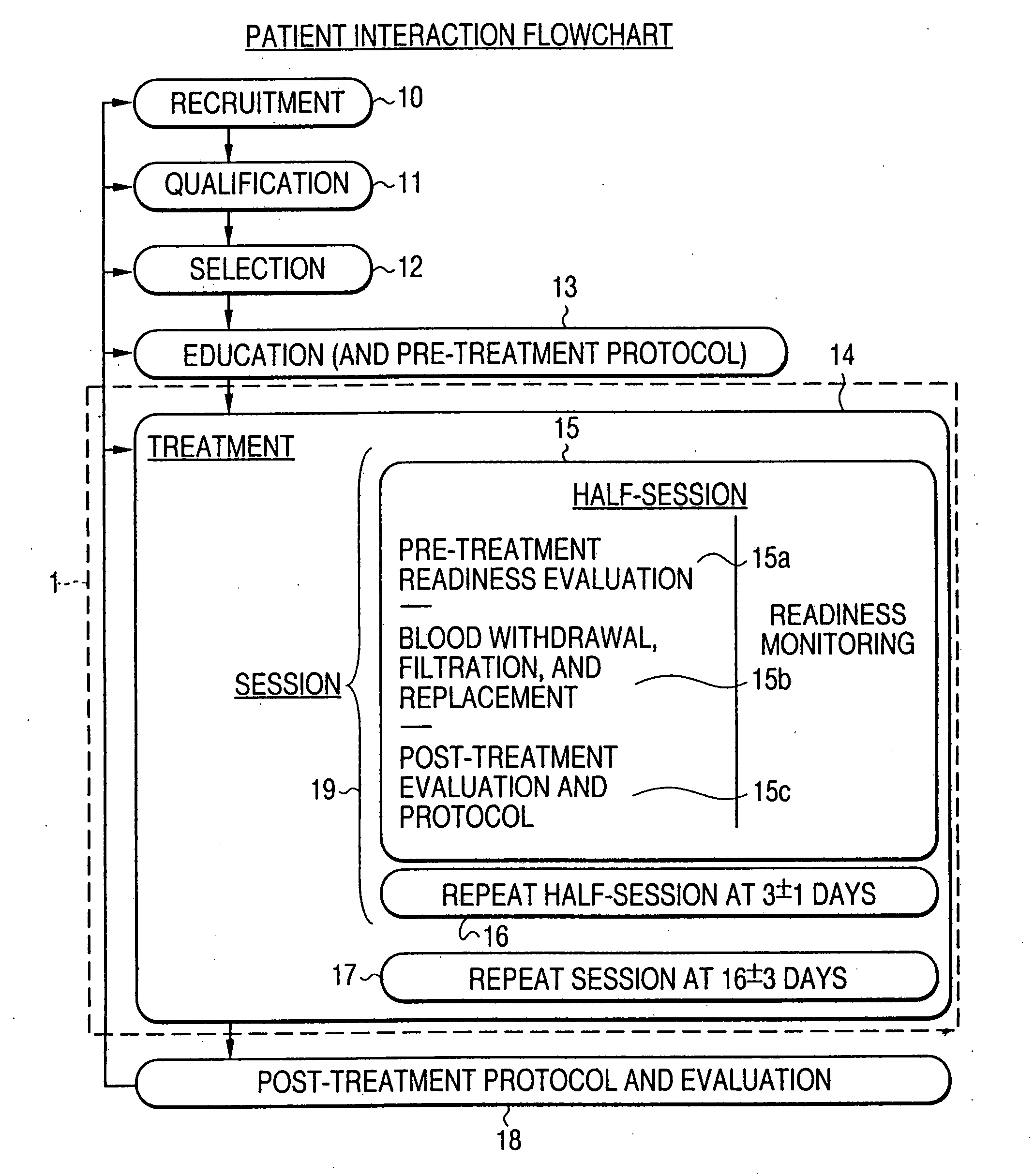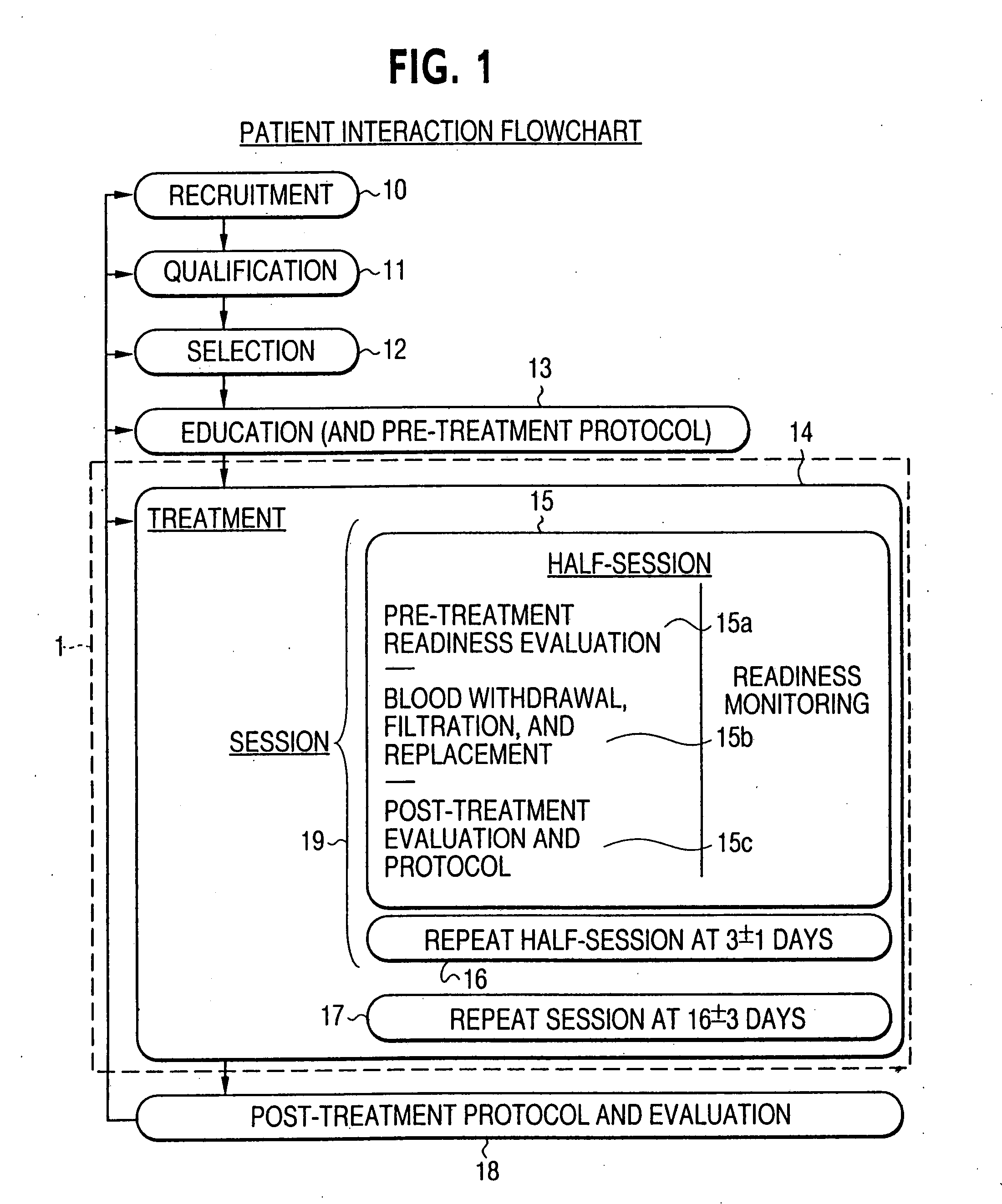Rheological treatment methods and related apheresis systems
a technology of apheresis and treatment methods, applied in the field of rheological treatment methods and related apheresis systems, can solve the problems of less robust (resilient) than the younger acute patient group, the use of apheresis to treat such chronically ill patients is relatively limited, and the clinical state is pathologic deterioration, etc., to achieve superior therapeutic effect, superior therapeutic effect, and optimal therapeutic effect of apheresis
- Summary
- Abstract
- Description
- Claims
- Application Information
AI Technical Summary
Benefits of technology
Problems solved by technology
Method used
Image
Examples
example 1
Example of an Apheresis Session
[0149] During an apheresis session, a patient reclines in a comfortable blood donation chair and intravenous (IV) lines are introduced, one into the antecubital vein of each of his or her forearms. (Single arm access methods and central lines or PIC lines are also possible but are less desirable). The IV catheters are either 17 gauge steel needles or 14 gauge plastic IV catheters, depending upon the caliber and location of the blood vessels to be cannulated. Blood is optimally withdrawn and circulated from the patient at a rate in the range of 75 to 150 cc / min. The time to complete an apheresis procedure of this invention varies from patient to patient, and from day to day depending upon numerous variables. However, the average time required to process 80% to 120% of a typical patient's plasma volume, usually requires 1.5 to 2.5 hours for the average AMD patient, who serves as the prototypical example.
[0150] The blood is pumped out of the body via an...
example 2
Treatment of AMD
[0162] The skilled artisan will understand that AMD serves as the prototypical model for chronic, age-related, degenerative, atherogenic, thrombotic or inflammatory diseases, especially those manifesting disturbances of blood rheology, of which other examples are mentioned above. The body of work, discussed above, by Brunner, Berrouschot and others generally supports the basis of the present invention that the depletion and / or removal of these blood proteins leads to numerous interrelated alterations in blood rheology, along with their secondary and tertiary effects. While these effects may be more generally distributed, in AMD the changes appear to promote a return to function in ostensibly senescent but otherwise viable cells in the posterior retina.
[0163] Drs. Swartz and Rabetoy (publication pending) conducted research at the University of Utah that demonstrated that select patients with Dry AMD who demonstrated significant improvement in their visual function a...
example 3
Treatment of Atherosclerotic Disease
[0182] Atheromatous diseases develop as a result of lipid-laden plaques that slowly form preferentially within the intimal walls of coronary, carotid, aortic, pelvic, femoral, popliteal and other arteries throughout the body, often in the presence of disturbed lipid metabolism. Three protocols for treating these diseases according to the methods of the present invention follow:
[0183] First, as providing secondary prevention for the precipitation of acute vascular or thrombotic events (as in procoagulant cardiac patients considered “at risk” and / or those patients receiving dialysis treatments that predispose them to increased risks of thrombotic events and accelerated atherogenesis), long-term weekly or bi-weekly treatments according to the present invention are contemplated, depending upon individual patient responsiveness to treatments. Measurement of specific RAMs and the kinetics associated with their depletion within these patients will affo...
PUM
 Login to View More
Login to View More Abstract
Description
Claims
Application Information
 Login to View More
Login to View More - R&D
- Intellectual Property
- Life Sciences
- Materials
- Tech Scout
- Unparalleled Data Quality
- Higher Quality Content
- 60% Fewer Hallucinations
Browse by: Latest US Patents, China's latest patents, Technical Efficacy Thesaurus, Application Domain, Technology Topic, Popular Technical Reports.
© 2025 PatSnap. All rights reserved.Legal|Privacy policy|Modern Slavery Act Transparency Statement|Sitemap|About US| Contact US: help@patsnap.com



